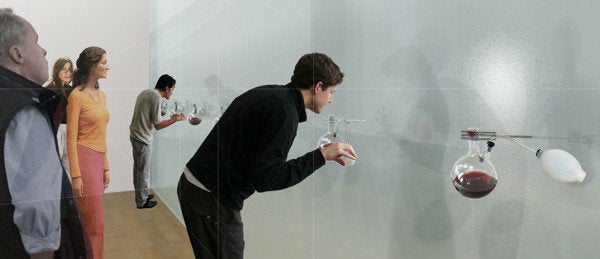
Food is percolating into many contemporary discussions, becoming an important subject among art and design circles. As evidenced in recent designs and exhibits, research and projects being done at architecture schools, and articles in design magazines and blogs, there is a food boom permeating every area and scale of design. But what is it all about? Why is food such a hot topic? And how can the food culture and culinary arts influence and be influenced by design?
On one hand, there have been an increasing number of unique and cool design objects engendered by the growing focus on the kitchen and food culture. From high tech and modern, to rustic and marking a return to the basics, designs for food containers, utensils, and ultra-modern kitchens are on the rise as designers and architects reconsider the ingredients, tools and appliances for food processing.
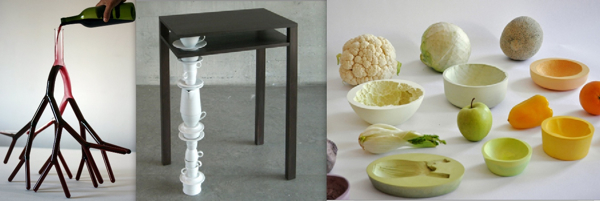
Carafe No. 5 by Etienne Menau
Ben by mischer'traxler - www.mischertraxler.com
Reversed Volumes by mischer'traxlr - www.mischertraxler.com
Technology has entered the food culture in the form of both, sustainable and high-tech kitchens and appliances. Responding to a heightened concern with food production and processing, there is a high demand for ethically sourced food and low-energy consumption appliances. Sustainable kitchens, and those that allow to grow and to store ingredients in greener alternative ways, are becoming widely spread and practically a must.

Kitchen by Zaha Hadid - Image from http://www.leblogdeco.fr
Ekokook by Faltazi - http://www.faltazi.com/ekokook/
Design Academy Eindhoven Student Project at Milan fair - http://static.dezeen.com/uploads/2010/12/dzn-Design-Academy-Eindhoven.jpg
Other advanced technologies, like the food 3d printer developed by Phillips Design, are bound to change what can be done in our cuisine, but will take longer to be accepted and incorporated to the mainstream food culture that today prefers products that are as organic and natural as possible.
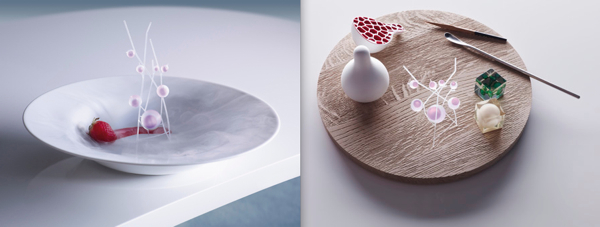
3d printed food by Phillips Design - www.design.philips.com
There is also an increasing trend that focuses on food design per se, trying not just to enhance how food is presented, but taking food as a new material for artistic production all together. It is not a secret that the better our food looks, the more tempting it becomes. However, it is only recently that chefs like Marc Bretillot and some of his students, such as Delphine Huguet, are bening the boundaries of what we typically encounter on our plate. Their creative designs arguably start blurring the boundary between cuisine art and the rest of the arts. These works have a concept, they are bold and creative, they are just done of edible material.

Marc Bretillot - http://media.paperblog.fr/i/301/3018966/workshop-sur-design-culinaire-avec-marc-breti-L-3.jpeg
Marc Breillot - http://www.refletsactuels.fr/wp-content/uploads/2010/05/ESAD.gif
Sweet " boum boum " Susie by Delphine Huguet - http://blog.sexyfood.fr/uplo/huget-9.jpg
Digestion by Delphine Huguet - http://blog.sexyfood.fr/uplo/huget-3.jpg
But the relationship between food and design goes much deeper than that.
Designing the experience and working with the senses
Food production and its consumption rituals have a direct impact on the design and layout of restaurants and homes. Food and space have an intricate relation; changing behaviors, patterns and priorities in the food culture result in new organizations, hierarchies of space, and typologies of the kitchen and living spaces. In the old days, cooking was done mainly by the servants, and kitchens were usually relegated to a separate area on the back of the house. Nowadays that cooking has become a social and even leisure activity, we find the kitchen has taken a central role in the layout and dynamics of houses and apartments, becoming open, ample and incorporated into the dinning and living spaces. Even the way we experience the kitchen has changed with the appearance of island kitchens, that allow for a more social cooking experience.
Similarly, restaurants have to be reconsidered too, adapting their typologies, layouts, and interior designs in order to respond to changes in the culinary world and patterns of consumption. Hel Yes is an example of a temporary restaurant and exhibit where a creative team of Finnish designers and food visionaries come together to rethink the furniture, design and story to reformulate the traditional ritual of eating.

Hel Yes - www.helyes.fi
Hel Yes - www.helyes.fi/
Eat Drink Design at Dutch Design Week 2010 - www.eatdrinkdesign.nl
Both, the culinary arts and design, work at the level of the experience and the senses. In this regard the world of food and cuisine are much more advanced, and there is a lot that we, designers and architects, can learn from it. Until not so long ago, architects thought of space mainly in a Cartesian way, with a purely visual and formal focus. We have finally started to think of what can be done to design for our senses, going beyond the visual, to include the olfactory, tactile and gustatory experiences. There is still much more we have to learn and explore, and we should try to incorporate some of the lessons we find in the kitchen. What if architecture was not only an object constructed with bricks, but we had other non-physical materials to work with? What if we could explore space through such intangible things as light and temperature,or even smells and tastes?
When we were at architecture school, Hugh Hayden was one of the first to go beyond our typical potlucks and cooking fests, to really start exploring what it meant to construct an entire experience, designing not only the elaborate food, but also the recipients, the space, the specific sequence of events, and even the attires of participants.
Today Hugh is not alone; creating dining scenarios has become a common theme not only among current students at Cornell, but there is also a wave of young designers across the world exploring the boundaries of food as performance and holistic experiences.
From formalizing the act of eating candy and their Snack Bar Wall, to their Gin and Tonic artificial indoor fog and Pharma Food, Food Design by Marti Guixe, re-designs food rituals and conventions. With his work, Guixe makes us think of food as a designed edible product without any reference to traditional cooking and gastronomy.

Candy Restaurant by Food Design - www.food-designing.com
Snack Bar Wall by Food Design - www.food-designing.com
GAT_FOG by Food Design - www.food-designing.com
Knoll, a Dutch firm by three young designers, proposes projects that integrate food, design and technology, to change the way we think about food, the way we interact with it and our surroundings. In their exhibit Techno Food, at the Dutch Design Week 2009, grapes that glowed with inner light, carrots that were fed by electrical power and lemons that were batteries in an electrical circuit, came together to present a futuristic dimension of food and technology.

Interselectible by Knol - www.knol-ontwerp.nl
Techno Food by Knol - www.knol-ontwerp.nl
Techno Food by Knol - www.knol-ontwerp.nl
The list of designers rethinking the rituals and scenography around food, the act of eating, and the whole multi-sensorial experience, has become quite extensive and it seems to be exponentially multiplying by the second.
The interest on investigating the potential for architecture in defining experiences that are not only visual or formal, but that engage multiple senses at once has also formally entered the academic circles and curriculum at schools of architecture. At McGill School of Architecture, this past semester Alberto Perez-Gomez and his students explored how to experientially tell a story engaging all the senses. Narrative and phenomenology came together with digital design and digital fabrication, through a culinary, tasting and spatial experiment in the MXT installation.
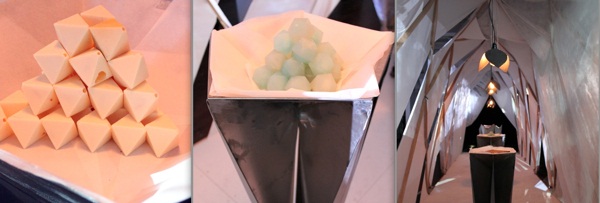
MXT BY Alberto Perez-Gomez students at McGill School of Architecture - Images from: www.archinect.com
At Harvard, GSD students and previous Cornellians, Day Jimenez and Mariela Alvarez, along with other MArch, MDesS, Phd and Landscape Architecture students, formed the group Project on Spatial Sciences, for students to get involved with the Lab at Harvard. Their first installation this past semester was Three States of Hors D'Oeuvres -another spatial tasting experience. Aimed to expand visitors' definition of space, this experiment made space breathable and tasteable. Visitors where handed trays with solid and liquid food samples, to consume in a kind of choreographed way as they traversed the four different chambers filled with different flavor clouds.

Three States of Hors D'Oeuvres by Project on Spatial Sciences at Harvard GSD - www.projectonspatialsciences.com
Images from: http://sphotos.ak.fbcdn.net/hphotos-ak-snc4/hs968.snc4/76172_165275250161544_138555019500234_390756_7273544_n.jpg
http://sphotos.ak.fbcdn.net/hphotos-ak-snc4/hs997.snc4/77074_165275136828222_138555019500234_390748_7943101_n.jpg
http://sphotos.ak.fbcdn.net/hphotos-ak-ash2/hs459.ash2/73203_165275190161550_138555019500234_390751_862495_n.jpg
To create this vaporous clouds they used the technology that the Lab had developed for Le Whaf -a machine that transforms liquid food into clouds. Le Whaf, created by David Edwards and Marc Bretillot, is an eloquent evidence of what lies ahead with the encounter of art and science. The technology that was initially developed by Edwards for the pharmaceutical startup company Pulmatrix, was used in a collaboration with Bretillot and Le Laboratoire's culinary laboratory to come up with an innovative design that expands into new gastronomic terrains and opens a new culinary era. As architects and designers, we are also left with the question of what can be done if taste - a sense never before associated with space and architecture- is now separated from the physical body of food to become, as smell, a floating and ethereal vapor in space.

Le Whaf by David Edwards, Marc Bretillot and Le Laboratoire - Images from www.egodesign.ca
Even smell, a sense that is easier to associate with a place -take for example the distinct smell when you enter a kitchen, a bakery or even a wooden house-, is only now slowly entering into the conversation of the arts and architecture world as a material to be explored.
I remember years ago, going to a Jannis Kounellis exhibit and being fascinated by one of his works that filled the room with ground coffee in steel receptacles hanging from the ceiling, completely transforming the usually pristine, odorless, and antiseptic environment of the museum. What was one of the few and isolated attempts to work with scent, is now becoming just one instance of the many more explorations being done.
The Center of Olfactory Art, dedicated to scent as an art form was launched at the Museum of Arts and Design this month, recognizing the importance of this almost neglected sense.
In the exhibition at the SFMOMA, Diller Scofidio and Renfro put together the exhibit "How Wine Became Modern: Design + Wine 1976 to Now", that culminated on a "smell wall". This sensory exhibit allowed visitors to inhale from a flask of wine that included an air pump to enhance the aroma.
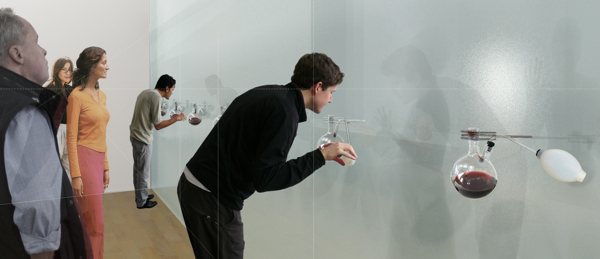
Smell Wall at How Wine Became Modern exhibit at the SFMOMA, by Diller Scofidio and Renfro -www.sfmoma.org / www.dsrny.com
From food we have a lot we can learn when it comes to sensorial material and experiences. Working with the senses in our designs allows us to work with a space that is no longer an empty vacuum but instead it organizes and carries information, waves, memories, and has extensive qualities and characteristics of temperature, smells, tastes, sounds and lights that can be controlled, choreographed and incorporated into the design as another material.
Design thinking
Another interesting point of contact between the culinary arts and design is their combination of art and science in a process that starts with a creative idea and basic ingredients, and through a progression you can guide, but only partially control, the ingredients are transformed into something else. With the recent important incorporation of science into the culinary world, the old dichotomy between art and science is starting to blur, and the almost alchemical process of cooking demystified.
We have been cooking for centuries; however, we are only now starting to know anything about what actually goes on when cooking. We have had a quite a volume of techniques and cooking books for a while now, but even if those created a repeatable magic in the kitchen, little was actually known of what was happening at a chemical level. Like magic, most cooking was based on old myths and deep-rooted believes, and much of the culinary invention in recent decades has been a result of trial and error rather than scientific research.
This started to change with the introduction of science and chemists into the world of cooking, and the food chemistry innovation brought about with the work of chefs like Ferran Adria and Hestal Blumenthal. All cooking is in the end soft-matter physics, these chefs are innovative in that they fostered and continue to expand the relation between science and cooking.
Ferran Adrià of El Bulli invented the foam cuisine after a friend gave him a canister of nitrous oxide with which he started to experiment. From foams and emulsions, to gelatin and polymer melts, first without knowing the chemistry behind most of his original creations, he continued to investigate further into the actual chemical and physical processes, manipulating them with hydro-colloids and techniques like spherification, to push the limits of modern cuisine. Adria is a deconstructivist, breaking food down to basic items to understand why it has the properties of texture and flavor it does, to then reconstruct them in a way that challenges our normal perception.
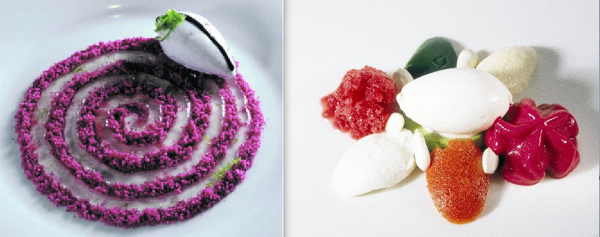
Ferran Adria creations - Images by:
Francesc Guillamet
http://blogs.rtve.es/blogfiles/elpostre/bulliok006.jpg
Ferran Adrià and the Harvard School of Engineering and Applied Sciences (SEAS) created a new undergraduate course on science and cooking that started this past fall of 2010, "Science and Cooking: From Haute Cuisine to the Science of Soft Matter". In this course cooking provides a familiar framework to study a variety of complex phenomena in chemistry, materials science and applied physics.
Hestal Blumenthal, from the Fat duck restaurant is another pioneer of modern cooking. He opened his own research and development kitchen in early 2004. Some of his signature techniques are: the use of a vacuum jar to increase expansion of bubbles during food preparation, the low temperature, ultra-slow cooking, and the Sous-vide cooking technique. All of these innovative and perfected cooking techniques allow for more controlled results and are used to enhance the desired food traits and properties.
Both Adria and Blumenthal are known for their inventive cooking techniques and for having revolutionized the art of cooking. Through a greater understanding of the physical parameters of food they learn how to manipulate them. They have changed all the rules and mythical norms, bringing about not only a better understanding of the chemical processes and what happens to food from a chemical point of view, but also an incredible creativity and freedom to the kitchen.
Matter is modified to express entirely different properties and effects. They transform the shape, the look, the feel, the taste. They create foods of interest, of surprise, of complexity. In their concoctions, unexpected contrasts of flavor, temperature, and texture, provoke and delight. Formal innovation is combined with philosophy and science. Eating is transformed into an entirely different experience, and so have they transformed the practice itself and its domain.
As architects we need this kind of design thinking, combining design imagination and rigorous science to challenge the unchallenged fundamentals, shatter preconceptions and change the practice itself.
Food production and distribution - Design at a larger scale
If we zoom out of the kitchen and look at food production and distribution at large, we will also find relevant links between food and design that are being explored today.
In recent years, a general augmented awareness of food production processes, technologies and methods, has resulted in a demand for healthier, more fair and ethically responsible food sources. This has become also a central subject matter in architecture, landscaping and urbanism, where we are focusing on how to optimize resource allocation, production methods and technology for a more efficient and responsible food production.
The fact that the theme of the upcoming International Expo in Milan 2015 is "feeding the planet, energy for life" is just one telling example of the research and design efforts that surround this important subject today.

Milan Expo 2015 - Images by Herzog and de Meuron at http://cdn.archdaily.net
Inevitably the technologies and patterns of food production and distribution affect and are affected by the design of land use and urban patterns. As designers, it is our responsibility to address these global issues and propose innovative design solutions.
Design and food will hopefully continue to become more tightly integrated in a productive relationship, influencing each other in fundamental and polyphasic ways. The inventiveness and innovation happening in the food world are to serve as inspiration and creative grounds for designers in every area. Food has become just another material for designers to work with -a very relevant, exciting, and rich material indeed.
-----------------------
Relevant links:
http://www.design.philips.com/
http://www.marcbretillot.com/index_2.html
http://huguetpourebullition.ultra-book.com/
http://www.projectonspatialsciences.com/Home.html
http://www.elbulli.com/
http://www.thefatduck.co.uk
http://www.dezeen.com/2010/11/22/food-and-design-report/
http://www.knol-ontwerp.nl
http://hughhayden.com/smooth.html
http://www.food-designing.com
http://www.mischertraxler.com